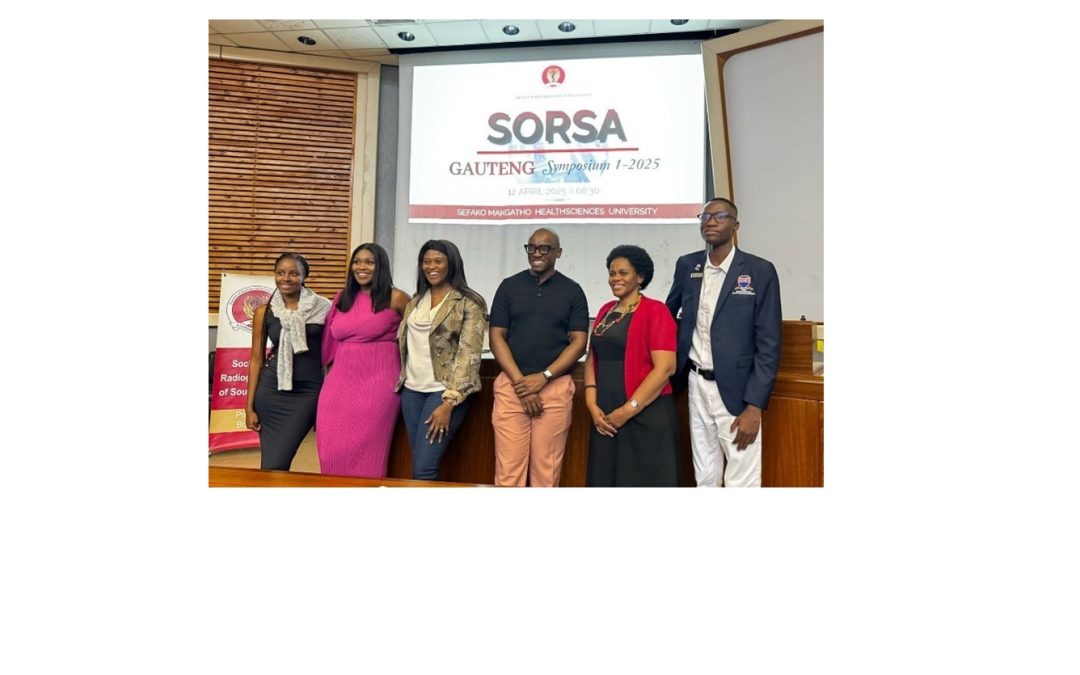
by Lorato | May 13, 2025 | All News, SMU Media, Student Media
Sefako Makgatho Health Sciences University (SMU) recently transformed into a dynamic centre of professional exchange and growth as it hosted the Society of Radiographers of South Africa (SORSA) Gauteng CPD Symposium on 12 April 2025. Organised in partnership with the SORSA, the event brought together students, academics, and practising radiographers in a unique blend of mentorship, education and inspiration.
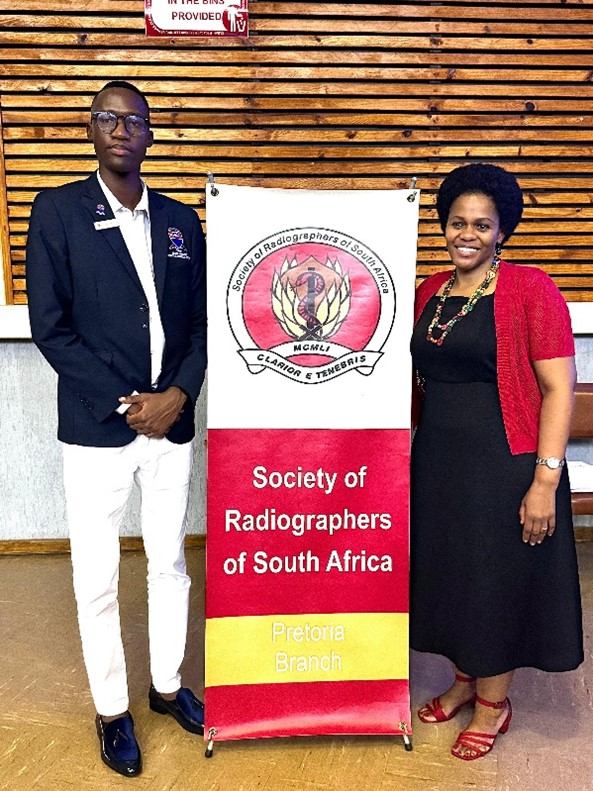 Accredited by the Health Professions Council of South Africa (HPCSA) for four General Continuing Education Units (CEUs), the symposium marked the first in-person CPD gathering in Pretoria since the onset of the COVID-19 pandemic. Radiographers from Gauteng and the North West Provinces converged on SMU to reconnect, learn, and shape the future of the profession.
Accredited by the Health Professions Council of South Africa (HPCSA) for four General Continuing Education Units (CEUs), the symposium marked the first in-person CPD gathering in Pretoria since the onset of the COVID-19 pandemic. Radiographers from Gauteng and the North West Provinces converged on SMU to reconnect, learn, and shape the future of the profession.
Khomotso Motiang, Lecturer in the Department of Radiography at SMU and an Interprofessional Education and Collaborative Practice (IPECP) Champion, co-hosted the event alongside third-year radiography student Enos Malatji. Both are proud SORSA members, and for Motiang, the event was deeply personal.
“When SORSA extended the invitation, I saw an opportunity to bring my long-standing vision of bridging the gap between students and professionals, theory and practice, and professional and personal growth,” she said. “Hosting the symposium at SMU was a way to plant a seed, show students they have a voice in the profession, and bring qualified radiographers back into the university space as mentors and partners in learning.”
That inclusive vision shaped every aspect of the event. “At its core, IPECP is about breaking down silos,” Motiang added. “We ensured multiple professions were represented in our presentations, reinforcing the importance of collaboration.”
Malatji, SMU’s first student SORSA member and founder of the SMU Radiography Student Association, said co-hosting the event was both daunting and empowering. “At first, it didn’t feel like something I could do,” he admitted. “But Mam Motiang encouraged me to lead and made me feel that my ideas mattered. That made all the difference.”
The symposium featured a rich variety of presentations—from breast and paediatric imaging to forensic radiography and radiation safety. Dr Fozy Peer, SORSA Public Liaison, remarked on the overall impact: “The presentations provided attendees with tools to enhance patient care, improve clinical decision-making, and inspire professional growth. It was about advancing the radiography profession through knowledge-sharing and collaboration.”
Kabelo Kgarosi, SMU’s Library and Information Services Manager, highlighted the importance of evidence-based practice. “Evidence synthesis is not the exclusive domain of academics,” he told attendees. “We must collaborate—librarians and radiographers—to produce quality, impactful research that influences real-world practice.”
This sentiment was echoed in Dr Peer’s interview following the event. “Research validates best practice, encourages critical thinking, and ultimately improves patient outcomes. It is vital that radiographers outside academia engage in it,” she said.
For final-year student Naledi Golulu, the symposium offered a platform to raise awareness about the realities of forensic imaging. “By sharing my experience, I hoped to highlight both the technical and emotional aspects of this field and the need for standardised protocols and support systems,” she explained.
Seasoned professionals also used the platform to reinforce essential principles. “My presentation focused on ethical responsibilities in radiation safety,” said Moyahabo Makgato. “It’s not just about compliance—it’s about safeguarding patients as a core element of ethical practice.”
According to Peer, interprofessional collaboration is central to improving radiographic practice. “Radiographers don’t work in silos. Collaborating with others, especially librarians and clinicians, ensures that radiographic practice remains informed, current and patient-centred,” she said.
Motiang’s most rewarding moment came when SMU students took the lead. “Seeing them confidently presenting, organising, and engaging—that was my full-circle moment,” she said. “It showed what happens when mentorship, leadership, and learning intersect meaningfully.”
Looking forward, she hopes the success of the event will catalyse greater SORSA involvement on campus. “We have a real opportunity to integrate SORSA into the academic journey—through student-led initiatives, mentorship and regular CPD activities.”
The SMU-hosted symposium was more than a professional development event; it was a declaration that the future of radiography lies in unity, innovation and shared purpose.
By Tumelo Moila
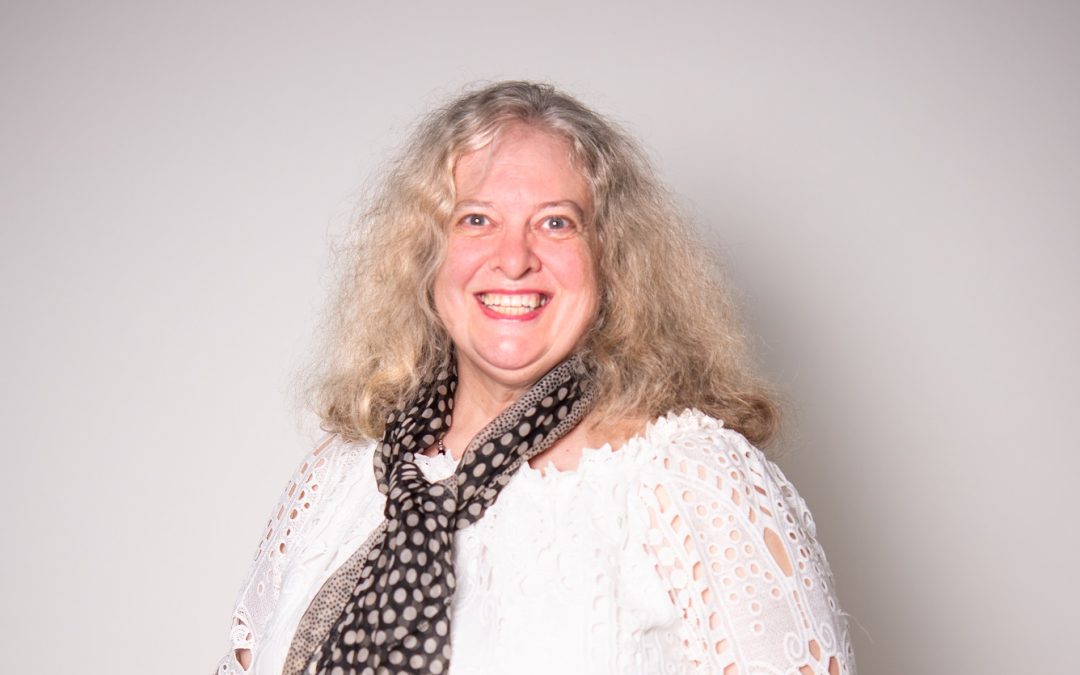
by Lorato | May 13, 2025 | Accolades and Achievements, All News, SMU Media, Student Media
Sefako Makgatho Health Sciences University (SMU) is leading advancements in medical research and innovation, identifying globally significant themes with societal impact. Central to this mission is Professor Anna Oettlé, a Full Professor in the Anatomy and Histology Department, whose exceptional contributions to anatomical research have earned her a prestigious accolade at the Vice-Chancellor’s Excellence Awards 2024.
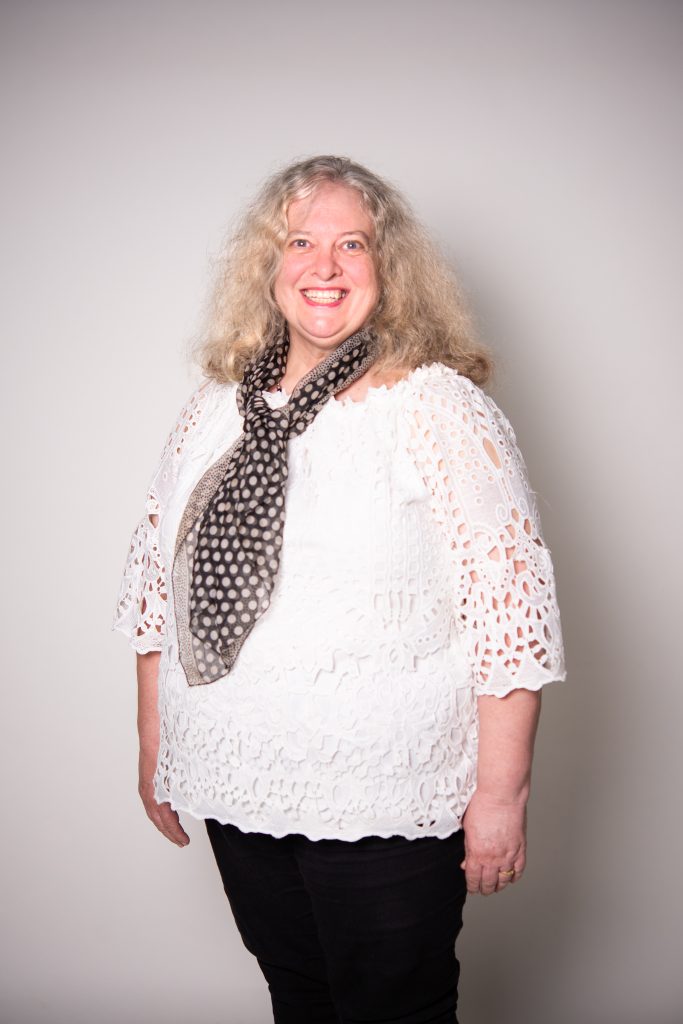 Oettlé qualified as a medical doctor at the University of the Witwatersrand in 1988 before pursuing an MSc in Anatomy with distinction. Transitioning into academia in 2002, she developed a keen interest in anatomical variations, which ultimately earned her an NRF C2 rating. “Clinical practice revealed the significance of anatomical variations in diagnosis and treatment. Modern 3D imaging techniques enhance visualisation, yet the principle of using multiple views remains essential,” she explains.
Oettlé qualified as a medical doctor at the University of the Witwatersrand in 1988 before pursuing an MSc in Anatomy with distinction. Transitioning into academia in 2002, she developed a keen interest in anatomical variations, which ultimately earned her an NRF C2 rating. “Clinical practice revealed the significance of anatomical variations in diagnosis and treatment. Modern 3D imaging techniques enhance visualisation, yet the principle of using multiple views remains essential,” she explains.
Oettlé’s research has evolved from traditional anatomical studies to advanced 3D imaging techniques. A landmark achievement in 2009 saw her collaborate with the South African Nuclear Energy Corporation (Necsa) to conduct the first cone beam tomography scans on human remains, revolutionising 3D anatomical analysis.
Her research spans bone and dental variation, craniofacial morphology, hominin evolution, and forensic applications. Notably, her work in biological profiling methods aids forensic scientists in identifying unknown victims, significantly contributing to criminal investigations.
The significance of an NRF Rating
An NRF rating validates a researcher’s contributions, enhances visibility, and unlocks funding opportunities. “Applicants must present five publications over eight years. A C2 rating confirms that all reviewers recognise the researcher as established, with impactful contributions and international collaborations,” she notes.
At SMU, institutional support has been invaluable. “SMU provides expert consultants to review applications and offer constructive feedback. Since joining in 2017, this environment has been instrumental in increasing my research productivity.”
Among her most cited studies is one that established an age classification system from sternal rib ends for South Africans, widely used in forensic profiling. “This study has been cited 143 times, assisting biological profiling. Similarly, our research on the mandible’s microstructure has crucial applications in orthodontics and forensic science,” she says.
Her research directly benefits medical practice, enabling clinicians to assess cephalopelvic disproportion during childbirth and inform dental procedures. It also equips forensic scientists with localised standards for facial reconstruction in missing persons cases.
Oettlé champions mentorship and interdisciplinary collaboration. “Engineers have helped refine 3D measurement techniques. Cross-disciplinary work fosters innovation. I mentor early-career researchers, believing in their potential and encouraging impactful work.”
She emphasises the role of NRF ratings in strengthening SMU’s research reputation. “These ratings drive early-career researchers to focus and secure funding. Increased funding facilitates mobility and international collaboration.”
Looking ahead, she aims to expand 3D scanning applications and enhance biological profiling methods. “3D imaging is becoming more accessible. My goal is to secure funding for advanced equipment and foster interdisciplinary collaborations.”
Reflecting on her VC Excellence Award recognition, she states: “It is an honour and a motivator to continue publishing. Previous awards funded research assistants to archive skeletal remains. I plan to use this funding to archive our scan collection at SMU’s central archives for future research.”
Encouraging aspiring researchers, she advises: “Dream big, work hard, and embrace new ideas. Stay positive and seek collaboration. Almost anything is possible with dedication.”
As SMU continues to drive medical research and innovation, its commitment to fostering excellence and collaboration ensures a lasting impact on healthcare. Through dedicated researchers like Oettlé, SMU is shaping the future of medical science, making transformative contributions to global healthcare.
By Tumelo Moila
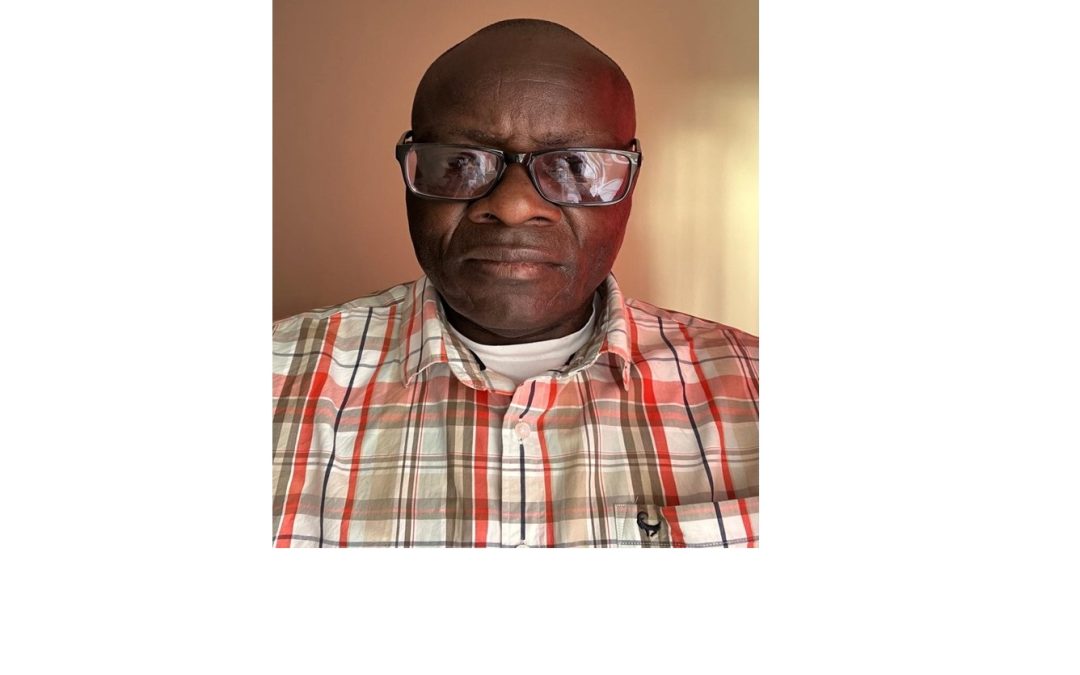
by Lorato | May 13, 2025 | Accolades and Achievements, All News, SMU Media, Student Media
Dr Benson Chuks Iweriebor, a postdoctoral fellow in the Department of Biology and Environmental Science at Sefako Makgatho Health Sciences University (SMU), has been awarded a C2 rating by South Africa’s National Research Foundation (NRF), recognising him as an established researcher with a sustained record of high-quality scientific output.
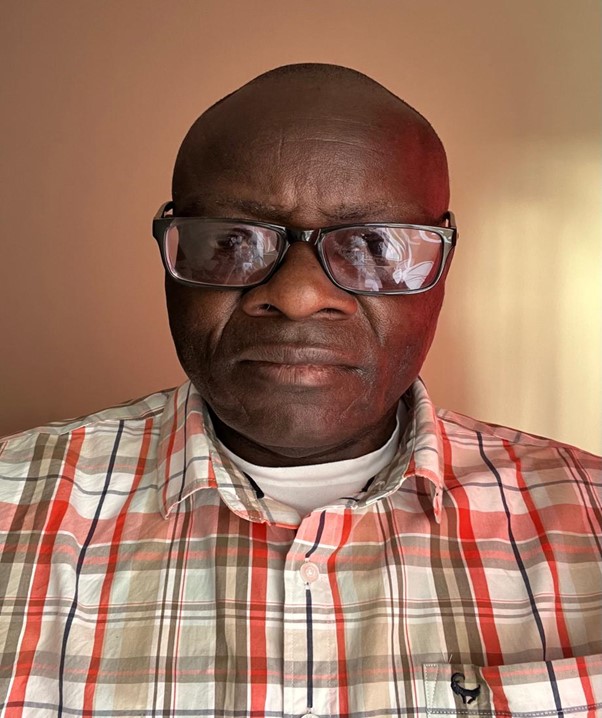 The NRF rating system serves as a benchmark for academic excellence in South Africa, evaluating researchers based on the quality and impact of their recent scholarly contributions. A C2 rating signifies that a researcher has produced a coherent and consistent body of work, demonstrating ongoing engagement with their field and the capacity to conceptualise and investigate complex problems.
The NRF rating system serves as a benchmark for academic excellence in South Africa, evaluating researchers based on the quality and impact of their recent scholarly contributions. A C2 rating signifies that a researcher has produced a coherent and consistent body of work, demonstrating ongoing engagement with their field and the capacity to conceptualise and investigate complex problems.
“The rating really means a lot to me as it will help me establish my footprints in the science community both locally and globally,” says Dr Iweriebor. “It enhances the national and international profile of the researcher’s institution.”
Iweriebor’s academic journey began with a doctoral degree from the University of Venda in 2012. He further developed his expertise during a research stint at the University of Virginia in the United States, collaborating with renowned HIV researchers. His tenure at the University of Fort Hare, working alongside Professor Lawrence Obi, was pivotal, as he secured funding from the NRF and the South African Medical Research Council (SAMRC) to advance his research outputs.
“Some of the major milestones that stand out for me include an award from the African Academy of Sciences for research on climate change and tick-borne disease, and travel grants from the Bill and Melinda Gates Foundation to attend international conferences,” he notes.
His research primarily focuses on infectious diseases, including studies on HIV and HIV drug resistance, circoviruses and parvoviruses affecting piggery and pork production, antibiotic resistance in wastewater effluents, and the prevalence of multidrug-resistant pathogens in various environments. He has also contributed to research on zoonotic diseases and the molecular characterisation of tick-borne pathogens in South Africa. With over 80 peer-reviewed articles, his steady publication record and collaborative efforts have been key to attaining his NRF rating.
Beyond his academic outputs, Iweriebor values mentorship. “I have mentored many scientists along the way. The majority of them are shining the light to brighten the corners where they are in the world,” he shares.
His research interests have evolved over the years, with a current focus on pathogen surveillance metagenomics. “It’s an emerging area of research that can help us better understand the diversity and complexity of microbial ecosystems,” he explains. “By analysing the genetic material of microorganisms present in a sample, researchers can gain insights into the composition, function, and dynamics of microbial communities.”
Iweriebor acknowledged the challenges he has faced in his research career, particularly related to funding and limited research facilities. “Being frugal with the little funds available and designing your research to fit the resources at hand has been the key,” he says.
Collaboration has been central to his scholarly work. “I am a co-author of all my publications. It wasn’t a lone effort but a collaborative endeavour,” he emphasises. He is also exploring interdisciplinary collaborations, particularly in leveraging medicinal plants to combat antimicrobial resistance.
Looking ahead, Iweriebor aspires to mentor more young researchers and stay abreast of technological advancements in his field. “To whom much is given, much is expected. This award is a call to work harder and to attain greater heights, all by his grace,” he reflects.
He expressed gratitude to his family, colleagues, and mentors, including Professor Obi, Professor Mapaseka Seheri, Professor Piet King, Professor Anthony Okoh, Dr Kayode Afolabi, Dr Oyinlola Olaokun, and Professor Nqobile Mkolo, among others. “Success is never achieved alone; it is a cumulative outcome of contributions made by several people,” he acknowledges.
Iweriebor’s recognition underscores the importance of sustained research excellence and collaboration in advancing scientific knowledge and addressing public health challenges.
By Tumelo Moila
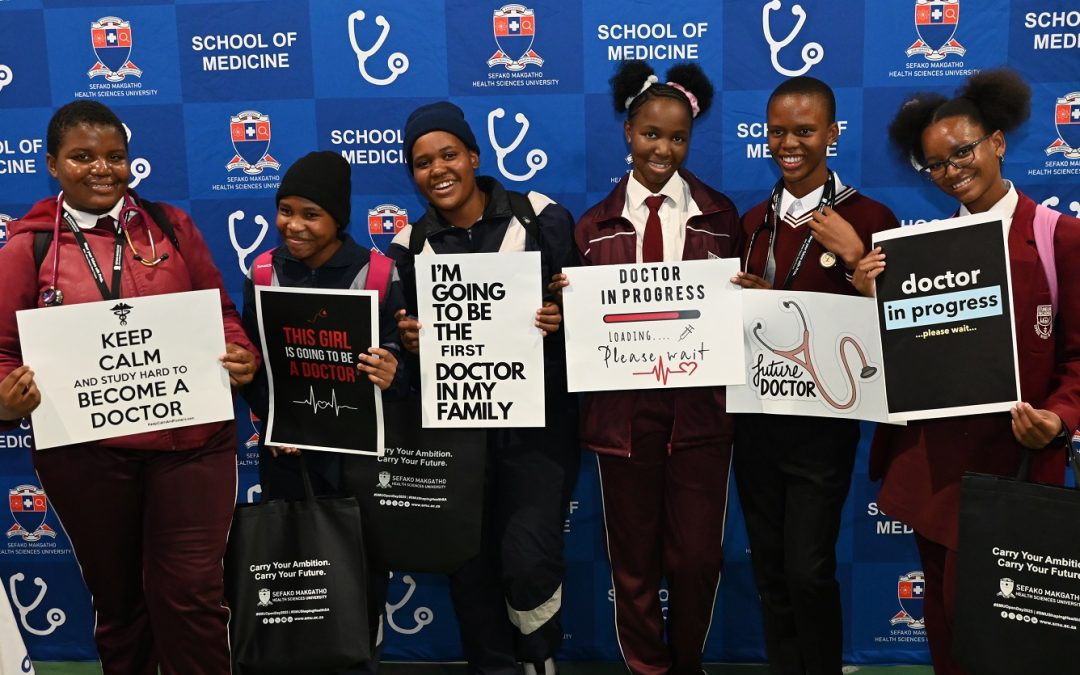
by Lorato | May 13, 2025 | All News, SMU Media, Student Media
Sefako Makgatho Health Sciences University (SMU) was abuzz with excitement and learning as it welcomed approximately 6,000 learners, parents, and educators to its highly anticipated 2025 Open Day. The event provided an immersive and informative experience for aspiring health sciences professionals.
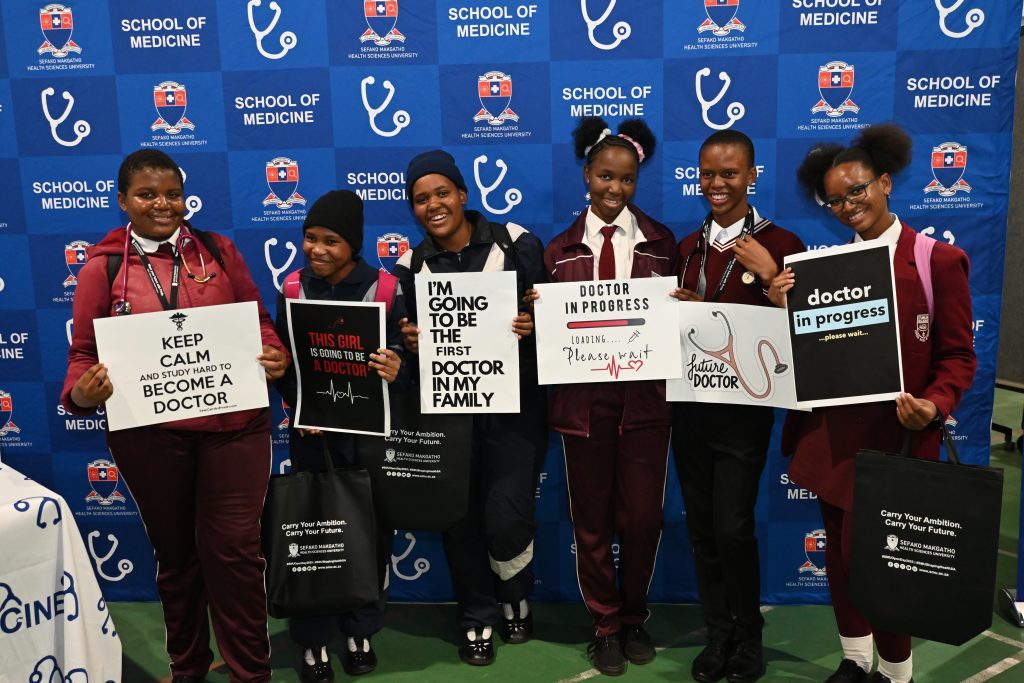 Hosted on the university’s campus the day served as a valuable platform for learners specialising in mathematics, physical sciences and life sciences—particularly those in Grades 10, 11 and 12—to explore academic offerings across SMU’s five schools: Dentistry, Health Care Sciences, Medicine, Pharmacy, and Science and Technology. Attendees engaged directly with academic staff, current students, and alumni while experiencing the university’s state-of-the-art facilities first-hand.
Hosted on the university’s campus the day served as a valuable platform for learners specialising in mathematics, physical sciences and life sciences—particularly those in Grades 10, 11 and 12—to explore academic offerings across SMU’s five schools: Dentistry, Health Care Sciences, Medicine, Pharmacy, and Science and Technology. Attendees engaged directly with academic staff, current students, and alumni while experiencing the university’s state-of-the-art facilities first-hand.
The programme featured interactive exhibitions, live demonstrations, guided campus tours, and individual consultations. Among the most popular exhibits was the Emergency Medical Care Unit from the School of Medicine, where staff conducted realistic trauma simulations, including CPR and spinal immobilisation techniques, captivating both learners and educators.
The School of Dentistry welcomed guests to the SMU Oral Health Centre, where students receive clinical training. Meanwhile, the School of Pharmacy introduced prospective students to its problem-based learning approach. This educational method enables students to collaboratively tackle real-world health issues, encouraging critical thinking, teamwork and self-directed learning, and promoting a deeper understanding beyond rote memorisation.
“I’ve always wanted to be a medical practitioner, but today made it feel real,” said Ashley Ngwenyama, a Grade 11 learner from Hazyview Comprehensive School in Mpumalanga. “The staff and students were so welcoming and explained everything in a way I could understand. I can’t wait to reach Grade 12 and apply.”
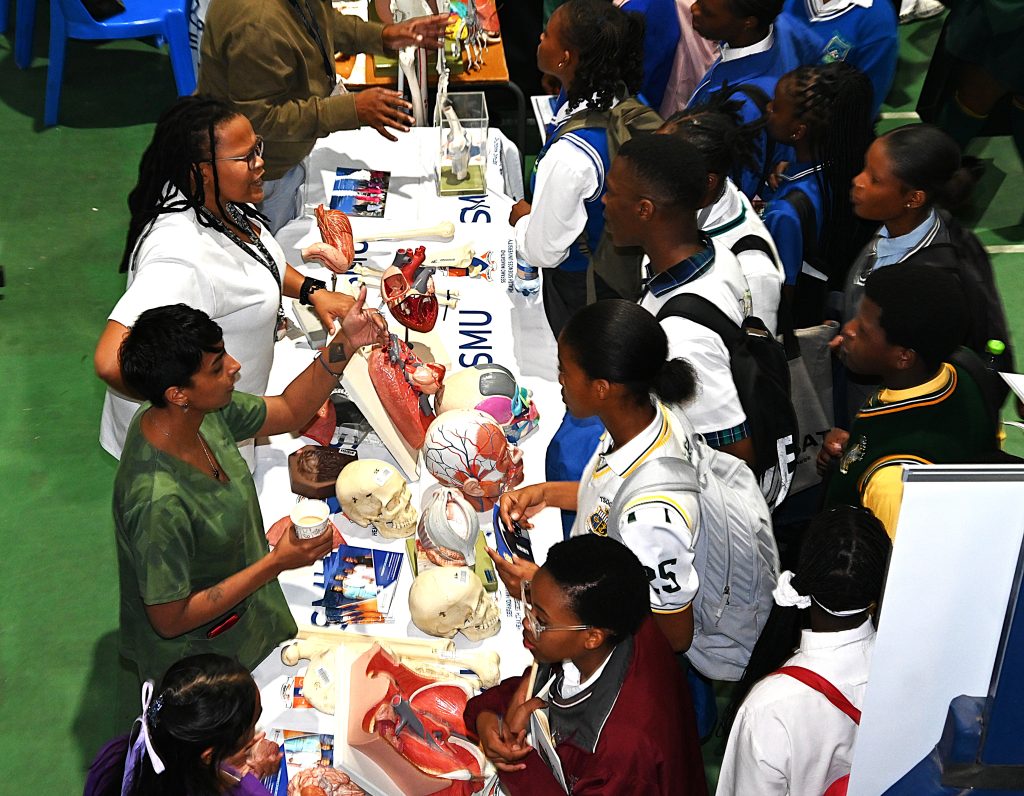 The Department of Occupational Therapy, under the School of Health Care Sciences, drew large crowds with its interactive displays on rehabilitation, human movement, and disability support. These exhibits encouraged learners to consider diverse and impactful careers within the healthcare sector beyond the more traditional roles.
The Department of Occupational Therapy, under the School of Health Care Sciences, drew large crowds with its interactive displays on rehabilitation, human movement, and disability support. These exhibits encouraged learners to consider diverse and impactful careers within the healthcare sector beyond the more traditional roles.
Academic staff, including lecturers and postgraduate students, were available throughout the day to provide detailed information on admission requirements, application processes, financial aid, and the extensive student support services offered at SMU. Visitors also toured the university’s cutting-edge laboratories, simulation centres, and the Oral Health Centre, which forms a vital part of students’ clinical education.
“We focus on both academic excellence and the development of compassionate, community-conscious professionals,” said Winnie Marishane, Manager: Branding and Marketing at SMU. “Open Day is about helping learners visualise their place in this ecosystem.”
Dedicated information sessions for learners, parents and educators covered essential topics such as NSFAS funding, student accommodation, campus safety, and mental health and wellness support—reinforcing SMU’s commitment to holistic student wellbeing.
“As an alumnus and educator, I appreciated the transparency and detail around student life and academic support,” noted Tiisetso Phooko, an SMU alumnus and Life Orientation educator at Machepelele Secondary School in Limpopo. “It’s reassuring to know that our learners will be in good hands.”
SMU’s student brand ambassadors played a crucial role in the day’s success, sharing their personal journeys and offering peer-to-peer advice to aspiring applicants. “I was once in their shoes, unsure about where to go or what to study,” shared Trevor Bvuma, a final-year Master of Science (Biology) student and ambassador. “Today, I am part of a university that values both excellence and Ubuntu. That’s the spirit we’re passing on.”
The School of Science and Technology also captivated learners with hands-on scientific demonstrations, sparking curiosity about careers in applied sciences and research. As the day drew to a close, learners departed with university prospectuses, application guidelines, and—most importantly—a renewed clarity and enthusiasm for their future paths.
With applications for the 2026 academic year now open—and closing on Thursday, 31 July 2025 for undergraduate programmes and the MSc in Clinical Psychology, and on Friday, 29 August 2025 for postgraduate programmes—SMU’s Open Day 2025 not only attracted an impressive turnout but also successfully inspired the next generation of South African health sciences professionals.
By Tumelo Moila
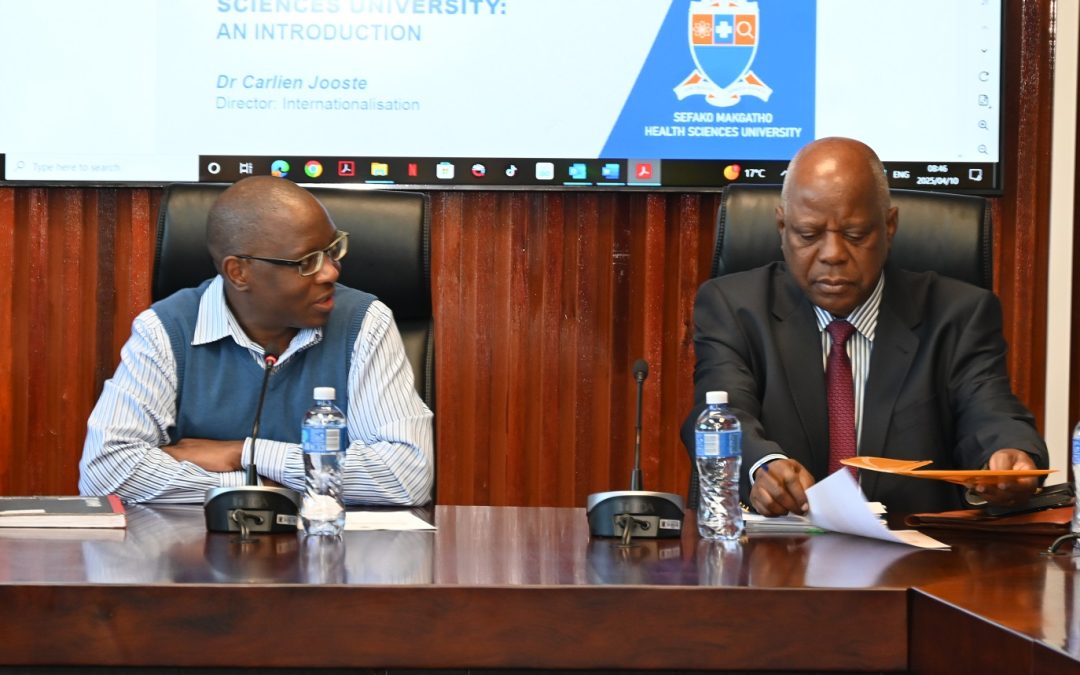
by Lorato | May 7, 2025 | All News, SMU Media, Student Media
Sefako Makgatho Health Sciences University (SMU) recently welcomed a delegation from Mozambique’s Universidade Wutivi (UniTiva), led by its Chancellor, Professor Domingos Tivane, for a high-level benchmarking visit. The visit focused on exploring best practices across SMU’s flagship academic programmes in medicine, pharmacy, hospital management, nursing and midwifery, and clinical psychology.
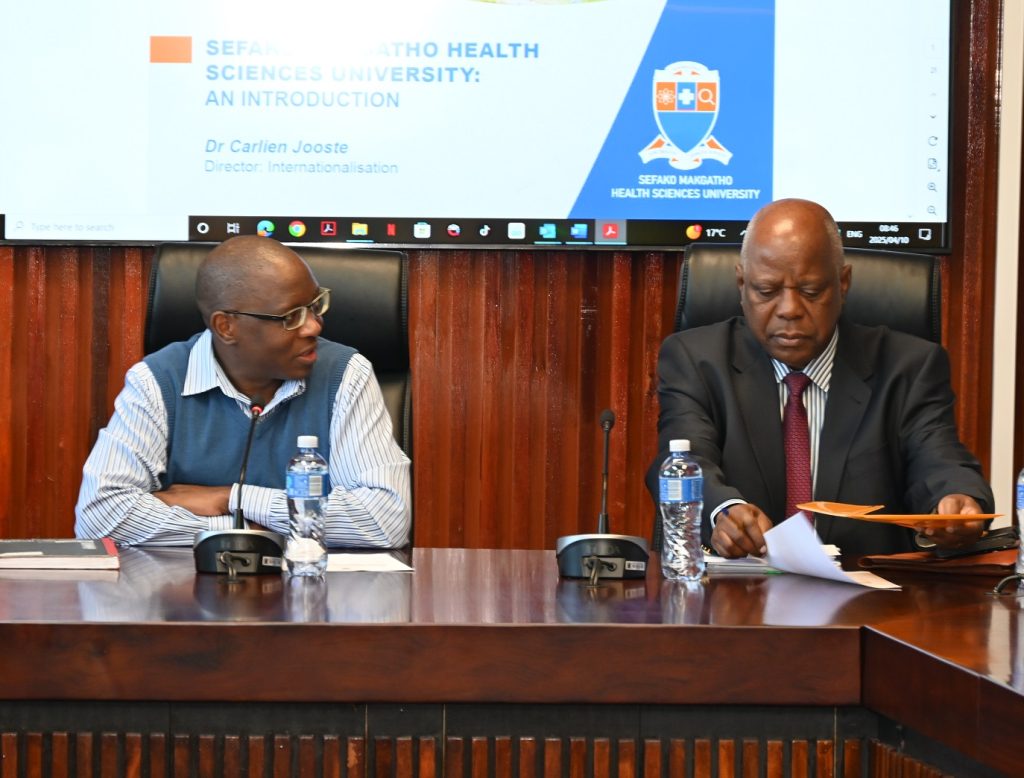 The day commenced with a warm welcome from Dr Jeffrey Mabelebele, Acting Deputy Vice-Chancellor: Teaching, Learning and Community Engagement, who emphasised the spirit of collaboration between the two institutions. “We are honoured to host Professor Tivane and the UniTiva delegation. This is an opportunity not only to showcase our strengths but also to learn from one another and build sustainable academic partnerships,” said Mabelebele.
The day commenced with a warm welcome from Dr Jeffrey Mabelebele, Acting Deputy Vice-Chancellor: Teaching, Learning and Community Engagement, who emphasised the spirit of collaboration between the two institutions. “We are honoured to host Professor Tivane and the UniTiva delegation. This is an opportunity not only to showcase our strengths but also to learn from one another and build sustainable academic partnerships,” said Mabelebele.
Dr Carlien Jooste, Director of Internationalisation, provided an overview of SMU’s institutional footprint and introduced the South African Policy Framework for the Internationalisation of Higher Education as the basis for the visit. Professor Tivane responded by reaffirming the purpose of the engagement.
“We are here to learn, to be inspired, and to build bridges between our institutions,” he said. “UniTiva is looking to enhance its own health sciences training, specifically Medicine, which will commence in July 2025, and SMU, with its track record of academic excellence, is the ideal institution to benchmark against.”
An insightful overview of the School of Medicine’s curriculum and operations was delivered by Gerda Botha and Professor Honey Mabuza, followed by a session on best practices per year level in the Bachelor of Medicine and Bachelor of Surgery (MBChB) programme. Notable contributors included Dr Edwin Seleka (MBChB I) and Professor Robert Ndou (MBChB II), with further input from Professor Honey Mabuza on undergraduate research and Thokozile Kgongwane on Interprofessional Education and Collaborative Practice (IPECP).
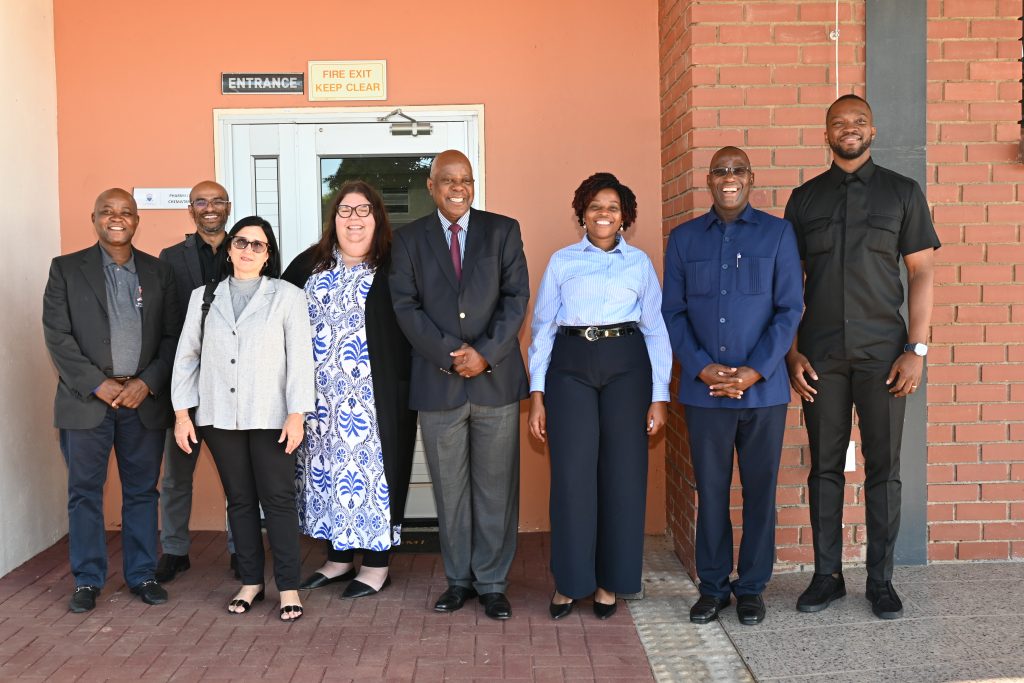 “Our fourth-year students are publishing in accredited academic journals, which speaks to the quality and impact of our undergraduate research training,” noted Mabuza. Professor Lesiba Baloyi was joined by colleagues Prof Mokoena Maepa and Maryke Pierce to discuss the University’s clinical psychology programme and their African-focused approach in SMU’s highly competitive postgraduate clinical psychology programme.
“Our fourth-year students are publishing in accredited academic journals, which speaks to the quality and impact of our undergraduate research training,” noted Mabuza. Professor Lesiba Baloyi was joined by colleagues Prof Mokoena Maepa and Maryke Pierce to discuss the University’s clinical psychology programme and their African-focused approach in SMU’s highly competitive postgraduate clinical psychology programme.
Thokozile Kgongwane, along with Skills Centre Director, Dr Lesego Phiri, then led the delegation on a hands-on tour of the SMU Skills Centre, offering a glimpse into simulation-based teaching and the university’s commitment to experiential learning.
The afternoon sessions focused on Nursing and Midwifery, Hospital Management and Pharmacy, where Dr Madan Poka outlined innovative teaching methods, student support, and community engagement initiatives.
“This visit is not just about showing what we do, but how we do it—our pedagogy, our partnerships, and our passion,” Dr Poka, Acting Dean of Pharmacy, observed.
Professor Sogo Matlala, Dr Andile Mokoena-De Beer, and Kgomotso Mabasa presented best practices in nursing, midwifery and hospital management. These included competency-based education aligned with the South African Nursing Council’s R174 regulations, incorporating rigorous objective structured clinical examinations (OSCEs), a 50% pass mark threshold, and 2,120 supervised clinical hours across key disciplines—closely aligned with international standards set by the United Kingdom’s Nursing and Midwifery Council (NMC) and European Union (EU) directives.
SMU’s unique IPECP programmes are redefining healthcare education through interprofessional collaboration, shared values, and ethical practice. The programme aligns with global frameworks from the World Health Organization (WHO) and the International Council of Nurses while maintaining a strong local impact.
“Our IPECP model improves patient outcomes, reduces duplication of resources, and supports our graduates to thrive in multidisciplinary teams,” noted Kgongwane.
Dr Jooste stressed that any Memorandum of Understanding (MoU) developed must be “intentional, mutually beneficial, and active.” A lively discussion on the potential MoU followed, setting the tone for future collaborations and an invitation for SMU delegates to visit UniTiva.
The day concluded with a tour of the School of Pharmacy laboratories and reflections on SMU’s continuous quality improvement efforts. These include quarterly academic review meetings, internal and external moderation processes, peer reviews, and student feedback loops that inform module planning and redesign.
SMU’s commitment to innovation was also on full display, from hybrid and flipped-classroom models to the integration of 3D-printed anatomical structures and dispensing software in Pharmacy education. The institution’s research-integrated curriculum prepares students for evidence-based practice, lifelong learning, and global competitiveness.
“We pride ourselves on excellence, innovation, and relevance. This benchmarking visit confirms that we are on the right track in shaping Africa’s next generation of healthcare professionals,” concluded Jooste.
SMU continues to set the pace in health sciences education across the continent, with international visits such as this reaffirming its role as a beacon of health care sciences academic excellence and societal impact.
By Tumelo Moila
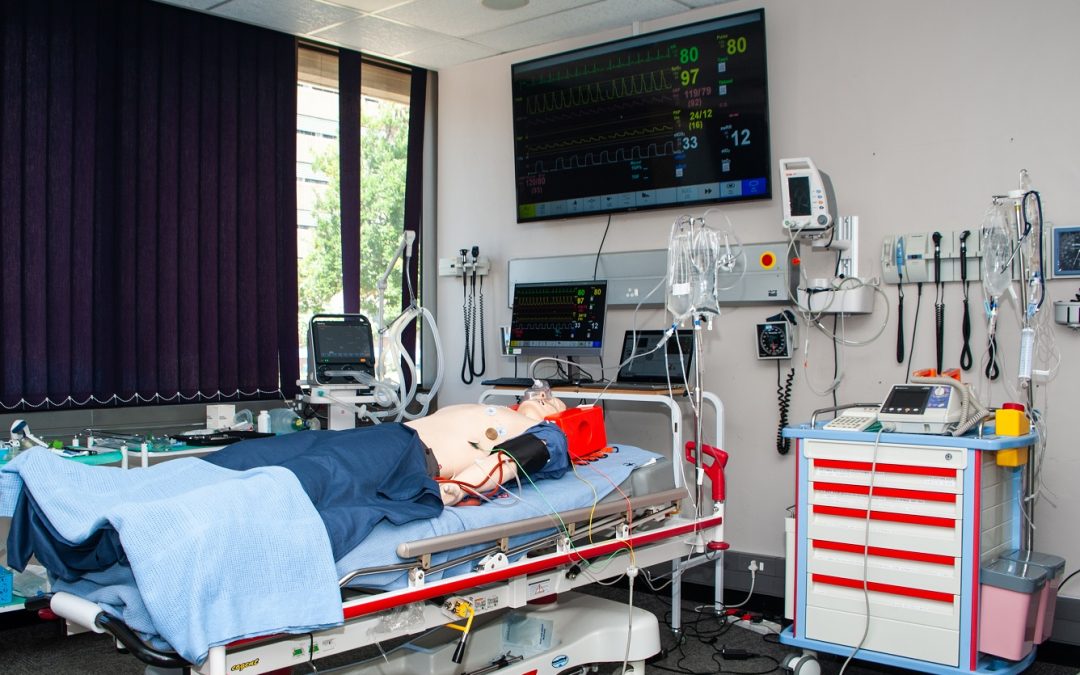
by Lorato | May 7, 2025 | All News, SMU Media, Student Media
The Sefako Makgatho Health Sciences University (SMU) is making waves in health sciences education through its state-of-the-art Skills Centre, which is redefining how future healthcare professionals are trained. Since its establishment in 2010, the facility has become a cornerstone of clinical teaching, offering a dynamic space for both undergraduate and postgraduate students to hone their skills in a realistic and controlled environment.
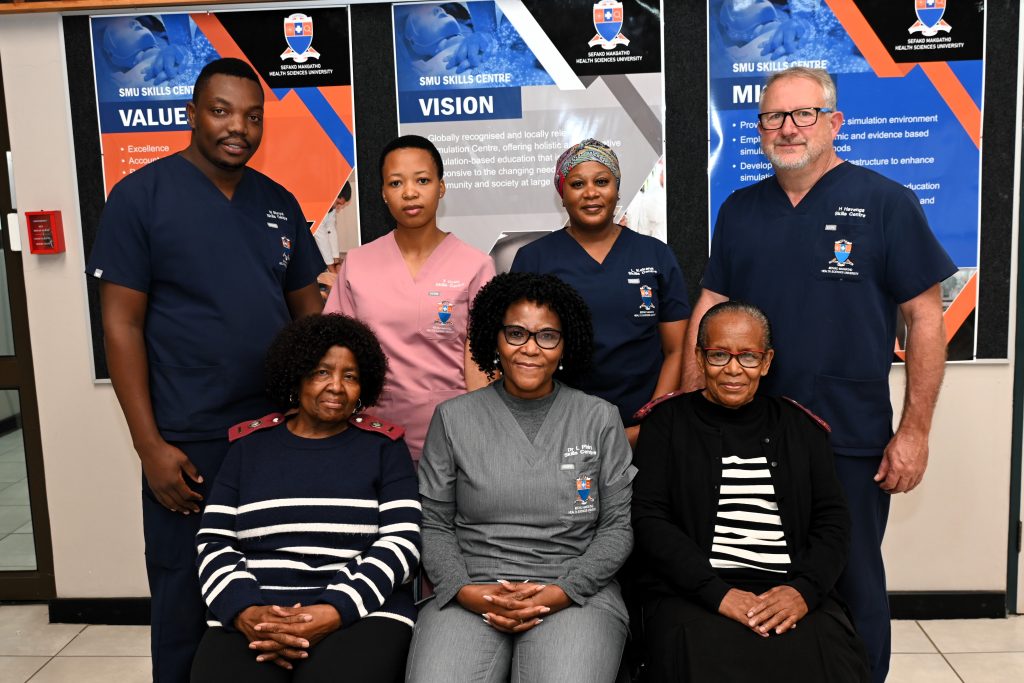 At the heart of the transformation is a simulation-based learning model that bridges the often-daunting gap between theory and clinical practice. From high-fidelity manikins and virtual reality systems to simulated patients, the Skills Centre equips students with the tools to learn, make mistakes, and improve—without compromising patient safety.
At the heart of the transformation is a simulation-based learning model that bridges the often-daunting gap between theory and clinical practice. From high-fidelity manikins and virtual reality systems to simulated patients, the Skills Centre equips students with the tools to learn, make mistakes, and improve—without compromising patient safety.
Dr Lesego Phiri, Director of the Skills Centre, emphasised the centre’s impact: “The Skills Centre is a game-changer for health sciences education at SMU. It provides our students with a unique opportunity to develop their clinical skills in a realistic and immersive environment, without the risk of harming real patients.”
The facility boasts four labs and four dedicated simulation spaces fitted with advanced health sciences equipment, including defibrillators, ventilators, and a variety of task trainers. It offers a suite of courses ranging from Basic Life Support and Primary Emergency Care to Advanced Cardiac Life Support, as well as competency assessments such as Objective Structured Clinical Examinations (OSCEs).
Phiri noted the continuous evolution of the facility. “The Skills Centre has improved greatly over the years, and it has ensured that graduates from SMU’s health sciences programmes are clinically competent, confident, and ready for real-world healthcare challenges.”
More than just a training ground, the centre promotes Interprofessional Education and Collaborative Practice (IPECP), bringing together students from various health disciplines to collaborate and develop teamwork and communication skills essential for quality patient care.
“We believe that IPECP is crucial for preparing our students for the complexities of modern healthcare,” said Phiri. “By working together, students can develop a deeper understanding of each other’s roles and responsibilities, leading to better patient outcomes.”
The Skills Centre has also reached beyond South African borders. Through partnerships with international institutions—most notably the Norwegian Agency for Exchange Cooperation (NOREC)—SMU has launched collaborative projects, including one with Haukeland University Hospital in Norway, focusing on trauma and emergency care.
“The NOREC project has provided a unique opportunity for healthcare professionals at Dr George Mukhari Academic Hospital (DGMAH), our clinical training partners, to learn. The Skills Centre, together with the Internationalisation Office, is now exploring ways to include our students, as this initiative was initially intended for professionals to learn from international experts and exchange best practices,” said Phiri. “This collaboration has enriched our training programmes and enhanced our research capacity.”
Innovation extends into technology. A smart camera system supports tele-simulation and remote learning, seamlessly integrated with platforms such as Blackboard, Zoom, and Microsoft Teams. These tools have proven vital for maintaining high-quality training, especially during the disruptions caused by the COVID-19 pandemic.
For students, the impact is tangible. “The Skills Centre is an essential resource for health sciences education at SMU,” said Kgaugelo Mahlwana, a final-year medical student. “It has helped me develop my clinical skills and confidence, and I feel well-prepared for my future role as a healthcare professional. Practising all the skills beforehand, rather than performing them directly on patients, really does boost our confidence. The facilitators are also excellent. Our Skills Centre has great facilities – including some impressive programmable simulated mannequins, which make the learning experience even more enriching.”
The Skills Centre’s reputation as a leader in healthcare education has attracted interest from universities and health institutions both locally and internationally. It is also an active research hub, with findings presented at global conferences and published in peer-reviewed journals.
“We are committed to providing our students with the best possible education and training,” Phiri added. “The Skills Centre is a key part of our strategy to produce clinically competent, confident, and compassionate healthcare professionals who can make a real difference in the lives of their patients.”
As the centre continues to expand its offerings and forge new collaborations, its influence on the future of healthcare training in South Africa—and beyond—is undeniable.
By Tumelo Moila

 Accredited by the Health Professions Council of South Africa (HPCSA) for four General Continuing Education Units (CEUs), the symposium marked the first in-person CPD gathering in Pretoria since the onset of the COVID-19 pandemic. Radiographers from Gauteng and the North West Provinces converged on SMU to reconnect, learn, and shape the future of the profession.
Accredited by the Health Professions Council of South Africa (HPCSA) for four General Continuing Education Units (CEUs), the symposium marked the first in-person CPD gathering in Pretoria since the onset of the COVID-19 pandemic. Radiographers from Gauteng and the North West Provinces converged on SMU to reconnect, learn, and shape the future of the profession.

 Oettlé qualified as a medical doctor at the University of the Witwatersrand in 1988 before pursuing an MSc in Anatomy with distinction. Transitioning into academia in 2002, she developed a keen interest in anatomical variations, which ultimately earned her an NRF C2 rating. “Clinical practice revealed the significance of anatomical variations in diagnosis and treatment. Modern 3D imaging techniques enhance visualisation, yet the principle of using multiple views remains essential,” she explains.
Oettlé qualified as a medical doctor at the University of the Witwatersrand in 1988 before pursuing an MSc in Anatomy with distinction. Transitioning into academia in 2002, she developed a keen interest in anatomical variations, which ultimately earned her an NRF C2 rating. “Clinical practice revealed the significance of anatomical variations in diagnosis and treatment. Modern 3D imaging techniques enhance visualisation, yet the principle of using multiple views remains essential,” she explains.
 The NRF rating system serves as a benchmark for academic excellence in South Africa, evaluating researchers based on the quality and impact of their recent scholarly contributions. A C2 rating signifies that a researcher has produced a coherent and consistent body of work, demonstrating ongoing engagement with their field and the capacity to conceptualise and investigate complex problems.
The NRF rating system serves as a benchmark for academic excellence in South Africa, evaluating researchers based on the quality and impact of their recent scholarly contributions. A C2 rating signifies that a researcher has produced a coherent and consistent body of work, demonstrating ongoing engagement with their field and the capacity to conceptualise and investigate complex problems.
 Hosted on the university’s campus the day served as a valuable platform for learners specialising in mathematics, physical sciences and life sciences—particularly those in Grades 10, 11 and 12—to explore academic offerings across SMU’s five schools: Dentistry, Health Care Sciences, Medicine, Pharmacy, and Science and Technology. Attendees engaged directly with academic staff, current students, and alumni while experiencing the university’s state-of-the-art facilities first-hand.
Hosted on the university’s campus the day served as a valuable platform for learners specialising in mathematics, physical sciences and life sciences—particularly those in Grades 10, 11 and 12—to explore academic offerings across SMU’s five schools: Dentistry, Health Care Sciences, Medicine, Pharmacy, and Science and Technology. Attendees engaged directly with academic staff, current students, and alumni while experiencing the university’s state-of-the-art facilities first-hand. The Department of Occupational Therapy, under the School of Health Care Sciences, drew large crowds with its interactive displays on rehabilitation, human movement, and disability support. These exhibits encouraged learners to consider diverse and impactful careers within the healthcare sector beyond the more traditional roles.
The Department of Occupational Therapy, under the School of Health Care Sciences, drew large crowds with its interactive displays on rehabilitation, human movement, and disability support. These exhibits encouraged learners to consider diverse and impactful careers within the healthcare sector beyond the more traditional roles.
 The day commenced with a warm welcome from Dr Jeffrey Mabelebele, Acting Deputy Vice-Chancellor: Teaching, Learning and Community Engagement, who emphasised the spirit of collaboration between the two institutions. “We are honoured to host Professor Tivane and the UniTiva delegation. This is an opportunity not only to showcase our strengths but also to learn from one another and build sustainable academic partnerships,” said Mabelebele.
The day commenced with a warm welcome from Dr Jeffrey Mabelebele, Acting Deputy Vice-Chancellor: Teaching, Learning and Community Engagement, who emphasised the spirit of collaboration between the two institutions. “We are honoured to host Professor Tivane and the UniTiva delegation. This is an opportunity not only to showcase our strengths but also to learn from one another and build sustainable academic partnerships,” said Mabelebele. “Our fourth-year students are publishing in accredited academic journals, which speaks to the quality and impact of our undergraduate research training,” noted Mabuza. Professor Lesiba Baloyi was joined by colleagues Prof Mokoena Maepa and Maryke Pierce to discuss the University’s clinical psychology programme and their African-focused approach in SMU’s highly competitive postgraduate clinical psychology programme.
“Our fourth-year students are publishing in accredited academic journals, which speaks to the quality and impact of our undergraduate research training,” noted Mabuza. Professor Lesiba Baloyi was joined by colleagues Prof Mokoena Maepa and Maryke Pierce to discuss the University’s clinical psychology programme and their African-focused approach in SMU’s highly competitive postgraduate clinical psychology programme.
 At the heart of the transformation is a simulation-based learning model that bridges the often-daunting gap between theory and clinical practice. From high-fidelity manikins and virtual reality systems to simulated patients, the Skills Centre equips students with the tools to learn, make mistakes, and improve—without compromising patient safety.
At the heart of the transformation is a simulation-based learning model that bridges the often-daunting gap between theory and clinical practice. From high-fidelity manikins and virtual reality systems to simulated patients, the Skills Centre equips students with the tools to learn, make mistakes, and improve—without compromising patient safety.